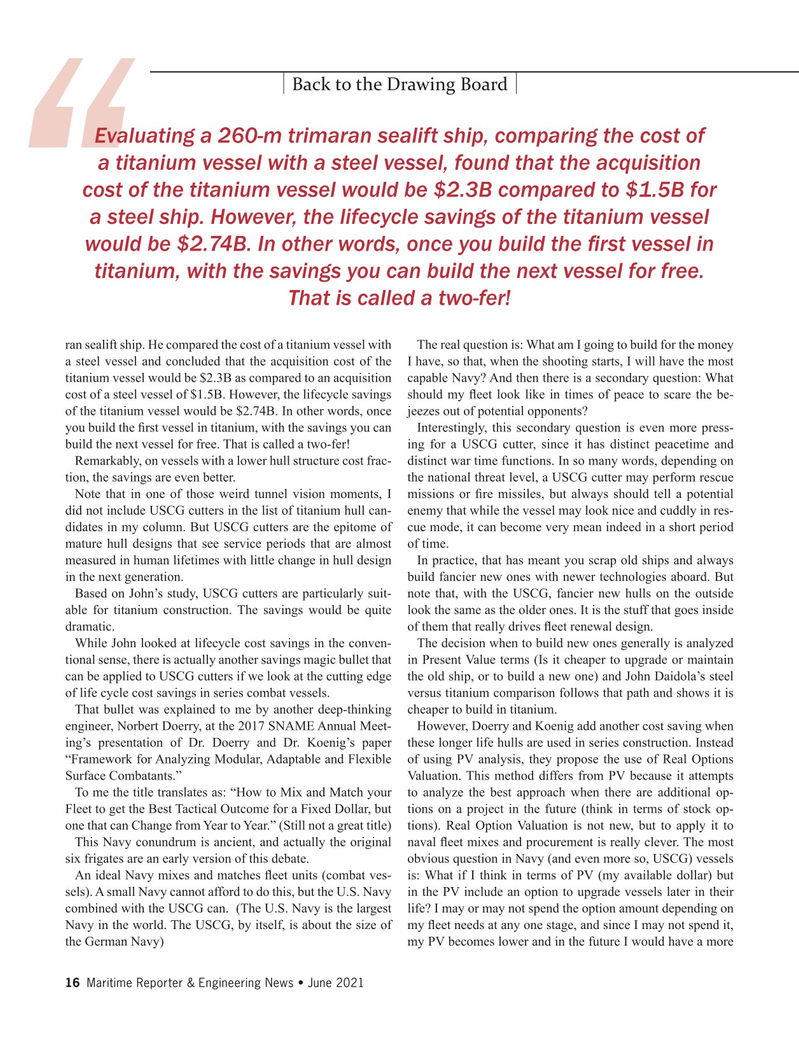
Page 16: of Maritime Reporter Magazine (June 2021)
USCG Fleet Modernization Annual
Read this page in Pdf, Flash or Html5 edition of June 2021 Maritime Reporter Magazine
Back to the Drawing Board
Evaluating a 260-m trimaran sealift ship, comparing the cost of a titanium vessel with a steel vessel, found that the acquisition cost of the titanium vessel would be $2.3B compared to $1.5B for a steel ship. However, the lifecycle savings of the titanium vessel would be $2.74B. In other words, once you build the ? rst vessel in titanium, with the savings you can build the next vessel for free.
That is called a two-fer!
ran sealift ship. He compared the cost of a titanium vessel with The real question is: What am I going to build for the money a steel vessel and concluded that the acquisition cost of the I have, so that, when the shooting starts, I will have the most titanium vessel would be $2.3B as compared to an acquisition capable Navy? And then there is a secondary question: What cost of a steel vessel of $1.5B. However, the lifecycle savings should my ? eet look like in times of peace to scare the be- of the titanium vessel would be $2.74B. In other words, once jeezes out of potential opponents? you build the ? rst vessel in titanium, with the savings you can Interestingly, this secondary question is even more press- build the next vessel for free. That is called a two-fer! ing for a USCG cutter, since it has distinct peacetime and
Remarkably, on vessels with a lower hull structure cost frac- distinct war time functions. In so many words, depending on tion, the savings are even better. the national threat level, a USCG cutter may perform rescue
Note that in one of those weird tunnel vision moments, I missions or ? re missiles, but always should tell a potential did not include USCG cutters in the list of titanium hull can- enemy that while the vessel may look nice and cuddly in res- didates in my column. But USCG cutters are the epitome of cue mode, it can become very mean indeed in a short period mature hull designs that see service periods that are almost of time.
measured in human lifetimes with little change in hull design In practice, that has meant you scrap old ships and always in the next generation. build fancier new ones with newer technologies aboard. But
Based on John’s study, USCG cutters are particularly suit- note that, with the USCG, fancier new hulls on the outside able for titanium construction. The savings would be quite look the same as the older ones. It is the stuff that goes inside dramatic. of them that really drives ? eet renewal design.
While John looked at lifecycle cost savings in the conven- The decision when to build new ones generally is analyzed tional sense, there is actually another savings magic bullet that in Present Value terms (Is it cheaper to upgrade or maintain can be applied to USCG cutters if we look at the cutting edge the old ship, or to build a new one) and John Daidola’s steel of life cycle cost savings in series combat vessels. versus titanium comparison follows that path and shows it is
That bullet was explained to me by another deep-thinking cheaper to build in titanium.
engineer, Norbert Doerry, at the 2017 SNAME Annual Meet- However, Doerry and Koenig add another cost saving when ing’s presentation of Dr. Doerry and Dr. Koenig’s paper these longer life hulls are used in series construction. Instead “Framework for Analyzing Modular, Adaptable and Flexible of using PV analysis, they propose the use of Real Options
Surface Combatants.” Valuation. This method differs from PV because it attempts
To me the title translates as: “How to Mix and Match your to analyze the best approach when there are additional op-
Fleet to get the Best Tactical Outcome for a Fixed Dollar, but tions on a project in the future (think in terms of stock op- one that can Change from Year to Year.” (Still not a great title) tions). Real Option Valuation is not new, but to apply it to
This Navy conundrum is ancient, and actually the original naval ? eet mixes and procurement is really clever. The most six frigates are an early version of this debate. obvious question in Navy (and even more so, USCG) vessels
An ideal Navy mixes and matches ? eet units (combat ves- is: What if I think in terms of PV (my available dollar) but sels). A small Navy cannot afford to do this, but the U.S. Navy in the PV include an option to upgrade vessels later in their combined with the USCG can. (The U.S. Navy is the largest life? I may or may not spend the option amount depending on
Navy in the world. The USCG, by itself, is about the size of my ? eet needs at any one stage, and since I may not spend it, the German Navy) my PV becomes lower and in the future I would have a more 16 Maritime Reporter & Engineering News • June 2021
MR #6 (1-17).indd 16 6/3/2021 2:11:27 PM

 15
15

 17
17
